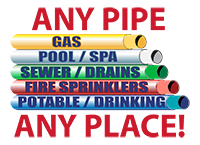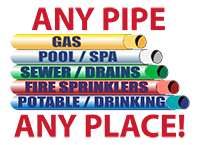Are you experiencing issues related to your water supply? Those problems can get annoying quickly and you cannot afford to ignore them due to the possibility they’re caused by your pipes. Replacing galvanized pipes may be something worth considering.
In this article, we’ll talk more about galvanized steel pipes. We’ll discuss why they are so common in older homes and the potential problems they pose.
Continue reading to find out what you need to do if you are experiencing issues that involve galvanized steel pipes. Use the information you learn here to decide how you’ll approach your plumbing-related problems.
The History of Galvanization
Before discussing pipe replacement or relining, let’s take a moment to talk about galvanized steel. Galvanized steel has been around for a remarkably long time.
According to the Galvanizers Association, the process of galvanizing itself dates to over three centuries ago. In 1742, Melouin, a known chemist, described a process that involved dipping a piece of iron into molten zinc to create a zinc coating. Melouin included those findings in a paper that he presented to the French Royal Academy.
Not long after Melouin’s discovery, the process of dipping iron into molten zinc became more commonplace.
Eventually, patents for the process of galvanization were registered. A person by the name of Sorel took out a patent for galvanization in France back in 1836. Then a British man named William Crawford patented the process a year later.
The practice of galvanization only became more widespread as the years went by. Even today, you can see the process of galvanization used in construction and manufacturing, among other things.
Why Are Pipes Galvanized?
The main reason they galvanize pipes is to improve their durability. To be more specific, the process of galvanization creates a barrier around the dipped material that provides increased protection against corrosion.
Continued exposure to the elements causes steel to corrode, and you cannot shield some steel from the elements forever, and that’s where galvanization comes in. With the help of galvanization, the steel surface has a better chance of withstanding the elements for an extended time.
Galvanization keeps the steel intact longer. The process can even offer protection against humidity, which is crucial given that we need many steel pipes for indoor operation.
The Potential Issues Related to Having Galvanized Pipes
As we’ve already discussed above, there was a time not too long ago when galvanized pipes were incredibly popular. Workers and manufacturers marveled at the durability and how it endured the punishment doled out by the elements.
Today, we understand that the process of galvanization can present problems of its own. Galvanized steel pipes can be problematic given how many of them we use inside homes and other establishments.
For this section of the article, let’s highlight some of the main concerns related to galvanized pipes. Weigh the information in this section and ask yourself if it’s time to consider replacing galvanized pipes in your home.
The Galvanized Steel Pipes May Contain Traces of Lead
You may have assumed that you didn’t need to worry about lead poisoning because no lead pipes are present inside your home. However, lead could still be a threat if you have galvanized steel pipes installed.
The issue here is related to how they created some of the older galvanized pipes.
Back then, they dipped the steel pipes in naturally occurring zinc. That turned out to be a big problem because the natural zinc contained a wide variety of substances. Among those substances was lead.
According to the EPA, those lead particles may have stayed on the surface of the galvanized pipes early on. They were not a threat to you back then.
As the pipes continue to age, though, the lead particles may fall into the water flowing in your home. The water from your shower or kitchen faucet may contain traces of lead if it’s transported by older galvanized pipes.
Potential lead poisoning is not something you should shrug off.
In adults, lead poisoning can cause headaches, muscle pain, and high blood pressure among other nagging conditions. Lead poisoning poses an even greater threat to children since it can cause delayed development and learning problems, according to the Mayo Clinic.
The Galvanized Steel Pipes May Affect the Water Quality inside Your Home
Have you ever gone to the sink to wash your hands only to be greeted by the unpleasant sight of unclean water flowing from the faucet? It is not a pleasant experience. Unfortunately, it’s one you may encounter if you have galvanized pipes inside your plumbing.
Some galvanized pipes release traces of iron. Those bits of iron can fall into the water. The iron can then cause the water’s appearance and smell to change.
The water will turn slightly reddish-brown due to the iron, and it will smell. That doesn’t exactly sound like the type of water you want to bathe or wash your hands with.
Note too that the iron-infused water is problematic not only because of the unpleasant appearance or odor. It’s also troublesome due to how it may affect the different water fixtures in your home. You may need to replace several fixtures with your pipes if you don’t do something about the water quality.
The Galvanized Steel Pipes Can Affect Water Flow inside Your Home
The zinc barrier that coats the galvanized pipes offers protection, but it also causes problems. The issue here is mainly related to how the zinc reacts to the water.
Certain minerals found in the water flowing to your home may react with the zinc coating the galvanized pipes. The reaction can then cause a bit of plaque to form inside the pipe.
At first, that plaque is not going to cause problems. As you’ve probably guessed, though, the reactions between the minerals and the zinc coating only increase in number as more water moves through the pipes. Eventually, the layers of plaque may become so thick that they start to affect the flow of water inside your home.
Plaque buildup may first slow down the flow of water. It could explain why the water pressure in your home has gradually been decreasing.
The plaque accumulation may also spring some leaks. Those water leaks can damage your walls and floors if they remain unaddressed.
Continue to ignore the galvanized pipes, and the plaque may cause them to burst. You may live without running water inside your home for a while because of that.
When You Should Address the Galvanized Steel Pipes in Your Home
Galvanized steel pipes are likely going to cause problems at some point.
If you have the resources available now, replacing galvanized pipes is worth considering. Understandably, you may want to prioritize some other matters first. However, if some of the things detailed below apply to your pipes, you may want to do something sooner rather than later.
Your Galvanized Pipes Are Nearing the End of Their Expected Lifespan
Having galvanized steel pipes installed inside your home does not guarantee that you will experience problems. That said, those pipes may still cause problems as they continue to age.
According to HouseLogic, galvanized steel pipes used as supply lines have an expected lifespan of about twenty to fifty years. If your pipes are nearing the high end of that range, you may want to look into replacing them soon. At the least, you should start keeping a closer eye on them to prevent potential problems.
Rust Found on the Galvanized Steel Pipes and/or Pipe Joints
Performing periodic ocular inspections is recommended if you want to take better care of your plumbing. Some of the problems known to affect pipes will make an appearance first before they start disrupting your plumbing system.
While inspecting your pipes, remember to look for traces of rust. The presence of rust is a telltale sign that something’s wrong with your galvanized pipes. They portend the possibility of greater issues arising in the future.
You should also inspect the places where different pipes meet because the rust may already be accumulating there.
The Galvanized Steel Pipes Have Become Misshapen
Rust is not the only thing to watch out for when evaluating the quality of your galvanized steel pipes. You should also check out the form of the pipes themselves.
The form of the galvanized steel pipes should remain intact, with no visible signs of damage. If you see cracks, bumps, or even dimples, those are indicators that the pipes are compromised. You will need to act soon if you want to avoid serious problems related to your plumbing.
You’re Experiencing Plumbing-Related Issues
We already talked about some of the issues you may encounter due to having old, galvanized steel pipes installed inside your home. Once you start experiencing that firsthand, don’t think twice about checking them.
Should You Replace or Reline Your Galvanized Steel Pipes?
Let’s assume that you’re now experiencing some issues, or you’ve noticed the warning signs telling you those elements of your home are about to become problematic.
What should you do next? In all likelihood, you’ll need to consider either relining or replacing your galvanized steel pipes.
To make the decision easier, let’s examine those two options more closely.
The Benefits of Relining Your Galvanized Steel Pipes
Many homeowners opt for relining instead of replacing their galvanized steel pipes. Among the reasons why they decide to go for relining is cost.
Relining your pipes is an affordable way to improve your home. It’s an affordable procedure because you don’t need to bring new pipes in to get the job done.
You should also consider relining if you want the repairs completed in a hurry.
Perhaps the problems to your plumbing are affecting your kitchen and preventing you from using that part of your home. Resolving that problem as quickly as possible is important because you probably don’t want to live on takeout food for too long. Relining is a good move to consider in that situation.
Homeowners can also address lead and corrosion concerns by relining their galvanized steel pipes.
The Drawbacks of Relining Your Galvanized Steel Pipes
Relining can only do so much. Some pipes may be so badly damaged that relining may not be enough to restore them. If you leave damaged pipes because relining cannot do anything, they may still cause problems down the line.
The Benefits of Replacing Your Galvanized Steel Pipes
Replacing your galvanized steel pipes is almost like installing a new plumbing system. Once you replace them, you can experience what it’s like to have a new system working inside your home.
You can also increase the longevity of your plumbing system by replacing the pipes. Brass, PVC, and stainless steel pipes last longer than their galvanized steel counterparts. Install them inside your home, and you won’t need to worry about your plumbing for a long time.
The Drawbacks of Replacing Your Galvanized Steel Pipes
It will take some time before you can replace all the galvanized steel pipes inside your home. On top of that, the workers may need to cut into walls and floors to access them. Certain parts of your home may also be out of commission for a while during the pipe replacement.
Contact Your San Diego Plumber For Help With Replacing Galvanized Pipes Today!
Whether you’re planning to reline or replace your galvanized steel pipes, we at San Diego Plumbing & Pipelining can help you out. Reach out to us today, and let’s work on the issues that the galvanized steel pipes are causing inside your home.







